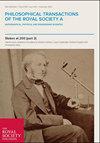凝聚态天体物理学:太阳系早期发展的限制和问题
Philosophical Transactions of the Royal Society of London. Series A, Mathematical and Physical Sciences
Pub Date : 2001-10-15
DOI:10.1098/rsta.2001.0902
引用次数: 3
摘要
我们讨论以下早期太阳系历史的基本问题。(i)精细年表,使用寿命长的U-Pb以及各种已灭绝的放射性核素。(二)构成行星的固体物质的性质。(iii)太阳系形成的直接史前史,包括可能的超新星触发问题。氧同位素异常的成因。在每一种情况下,我们都在努力区分我们所知道的和我们需要学习的。本文章由计算机程序翻译,如有差异,请以英文原文为准。
Condensed matter astrophysics: constraints and questions on the early development of the Solar System
We discuss the following fundamental problems of early Solar System history. (i) Fine chronology, using long–lived U–Pb as well as the different extinct radionuclides. (ii) The nature of the solid material from which the planets were made. (iii) The immediate prehistory of the formation of the Solar System including the question of a possible supernova trigger. (iv) The origin of anomalies in oxygen isotopes. In each case, an effort has been made to distinguish what we know from what we need to learn.
求助全文
通过发布文献求助,成功后即可免费获取论文全文。
去求助
来源期刊
自引率
0.00%
发文量
0

 求助内容:
求助内容: 应助结果提醒方式:
应助结果提醒方式:


